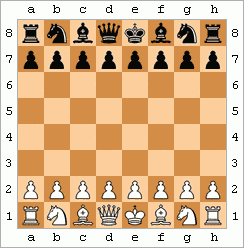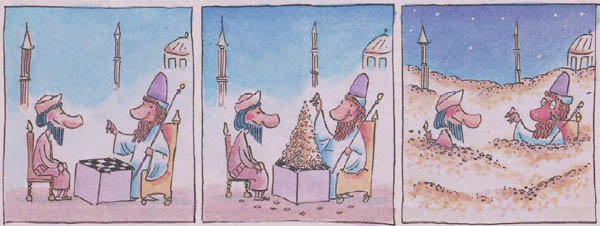| |
Why do we say “Checkmate”?
The earliest form of chess was known as "chaturanga" which means "four divisions (of the military)", represented by the pieces.
When the game spread to Persia, around the year 600 CE the name became "Chatrang" which subsequently evolved to "shatranj". In that part of the world, the king was called "Shah" and when you had your opponent's king in a position where the king could not escape from attack you would shout "Shah mat!" which means "The king is helpless!" Over time the words evolved to become "checkmate"

The amazing, ongoing chess game shown above comes from a web site called Wikimedia Commons.
This animated image was made by someone named Karophyr. People can create and share things on Wikimedia Commons - it is a wonderful resource to which anyone can contribute.
Image credits for this page:
Immortal game: Wikimedia Commons
Persian chess board: from an article called "The Secret of the Persian Chessboard, by Carl Sagan, in Parade Magazine, February 5, 1987.
Please read: About images and copyright.
|
|
 |
|
D O  T H E T H E  M A T H M A T H  - - O U R O U R  P O P U L A T I O N P O P U L A T I O N  G R O W T H G R O W T H  R A T E R A T E  I S I S  U N S U S T A I N A B L E U N S U S T A I N A B L E
Grains of wheat on a Chessboard - Part 2
How many grains on the whole board?
Each time we put grains in a square, the total number of grains on the whole board is one grain less than double the square we just filled. Take a look at the numbers in the chart to make sure you see that.
See that after we fill the 4th square with 8 grains, the total number of grains on the board is 15. That's one grain less than double the 8 grains we just put down.
When we have finished doubling for all of the 64 squares on the board, the total number of grains on the whole board will be one grain less than the number we would get by multiplying 64 2s together.
How many grains is that? Would that be a nice pile on your desk? Would it fill the room? Would it fill your school? Would it fill all of your town to a depth of 2 meters? How much wheat is it?
The answer:
By the time the doubling reached the 21st square, a million grains of rice were needed.
On the 64th square, there would be 9,223,372,036,854,775,808 grains of rice! (That's 263.)
The growth in any doubling time is greater than the total of all the preceding growth. Each time the amount of grain on one square doubled, the increase was more than all the grain on the board up to that time. By the time we reached the 64th square the total amount of rice on the whole chess board would be 18,446,744,073,709,551,615 grains of rice. That's 264 minus 1
That could be more wheat than humans have harvested in the entire history of the earth!

So, what does all this talk of grains of rice have to do with world overpopulation? Let's find out.
...read more
|

